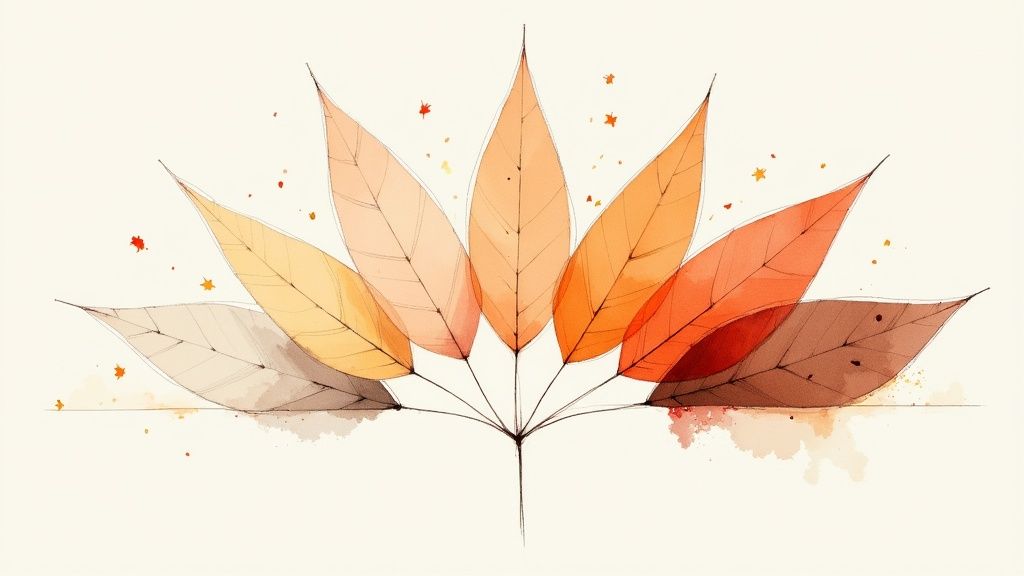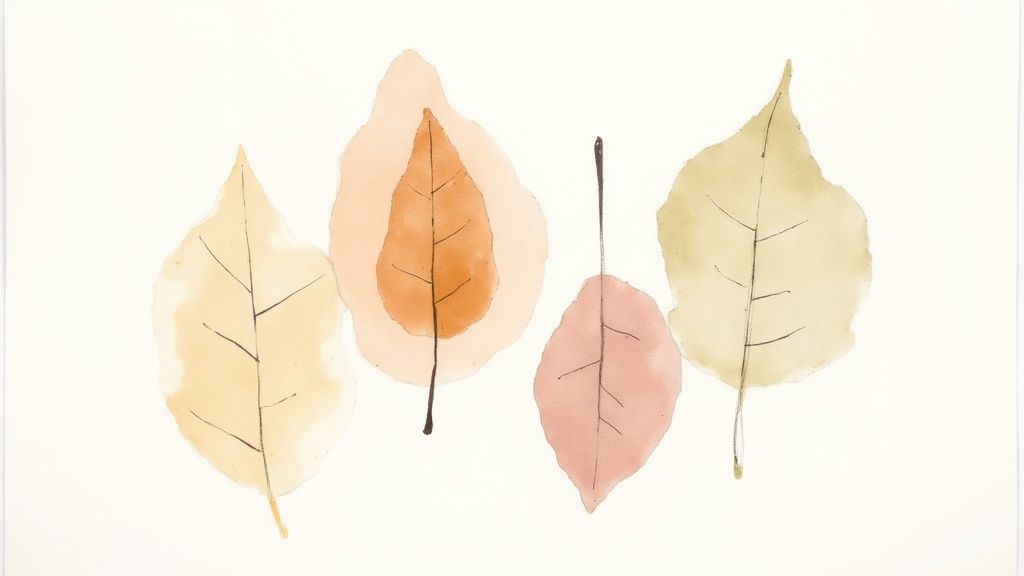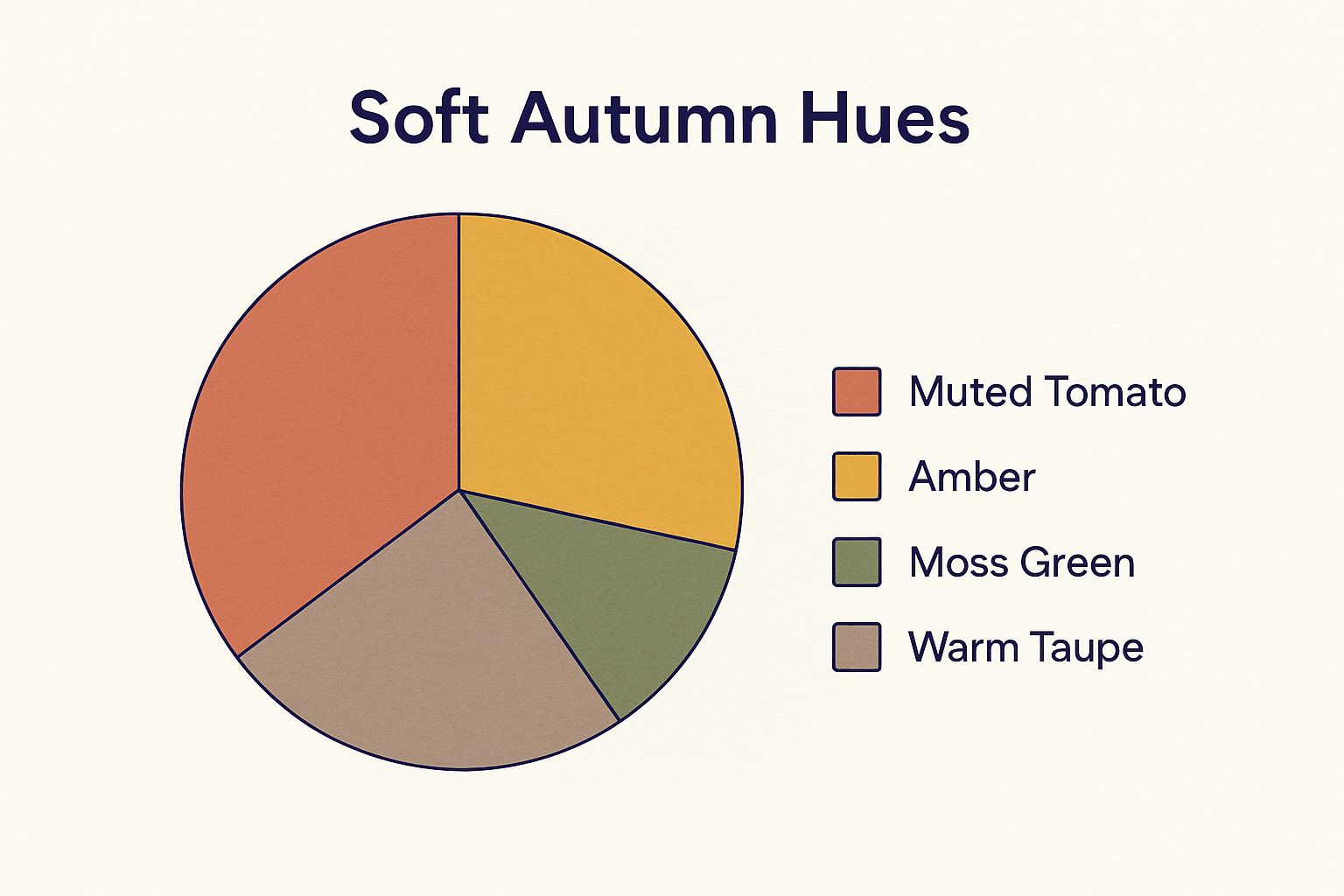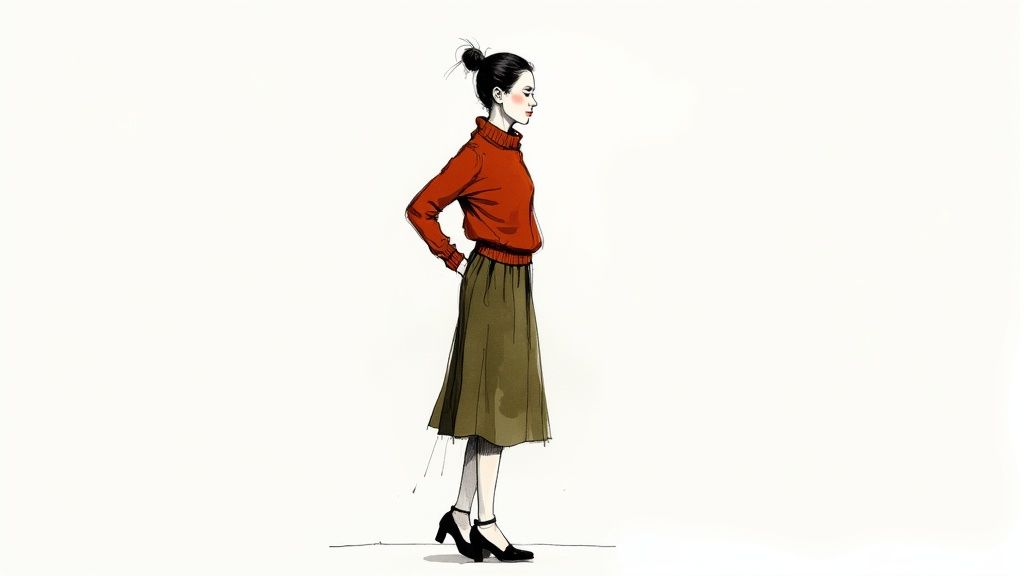
Your Guide to Soft Autumn Colors
By Emma Johnson - 10/3/2025
Picture the soft, hazy light of a late summer afternoon just before it slips into autumn. That gentle, warm glow is the very heart of the soft autumn colors. This palette is all about a neutral-warm undertone, a soft, muted intensity, and a medium value, coming together to create a look that's both earthy and incredibly sophisticated.
What Defines the Soft Autumn Palette

If you've ever felt that bright, high-contrast colors seem to wear you instead of the other way around, the soft autumn palette might feel like coming home. This season is one of 12 distinct categories in seasonal color analysis, a framework that helps you find the most flattering colors for your natural complexion, hair, and eye color.
What makes soft autumn so special is that it acts as a beautiful bridge between two other seasons. It borrows the cozy warmth from True Autumn but then blends it with the gentle, dusty serenity of True Summer. This mix results in a color family that's inviting and subtle, never overpowering.
Think of it this way: If True Autumn is a vibrant maple leaf at its peak in October, soft autumn is that same leaf a few weeks later—still beautiful, but softened by the sun and blended into the landscape. Its defining feature is, quite simply, its softness.
Understanding the Key Traits
To really get a feel for soft autumn colors, we need to look at three main characteristics that define the palette. Understanding these pillars is the first real step to seeing if these colors are your sweet spot.
Here’s a quick overview to get you started.
Soft Autumn Core Characteristics At a Glance
| Characteristic | Description |
|---|---|
| Hue (Undertone) | Primarily warm with a golden base, but softened and leaning towards neutral. |
| Value (Depth) | Sits in the medium range—neither extremely light nor overwhelmingly dark. |
| Chroma (Intensity) | Muted and soft. This is the most dominant trait; colors are desaturated, not bright. |
Let's break these down a little more.
- Hue (Undertone): The colors have a definite warmth, a golden or yellow base, but it’s dialed way back. It’s not the fiery, overt warmth you’d see in a True Autumn palette.
- Value (Lightness/Darkness): This palette avoids the extremes. You won’t find icy pastels or deep, stark shades like black here. Instead, it lives comfortably in the middle, favoring colors with a medium depth.
- Chroma (Intensity): This is the star of the show for soft autumn. The colors are muted, meaning they have a low chroma or saturation. Think of them as being softened with a little bit of grey, which makes them look gentle and blended rather than crisp and clear.
The magic of the soft autumn palette lies in its low-contrast, blended nature. The goal is to create a seamless harmony between your features and your clothing, where nothing shouts for attention, and everything flows together beautifully.
The overall effect is understated, sophisticated, and completely natural. The vibe is less about making a loud statement and more about a quiet, confident elegance that feels effortless. To see how this concept extends into other areas of style, you might want to explore the aesthetic of romantic, soft tones, which shares a similar philosophy.
How to Know If You're a Soft Autumn
So, you think you might be a Soft Autumn? Finding your seasonal home is less about ticking boxes and more about noticing the overall harmony of your natural coloring. It's about how your skin, hair, and eyes all work together to paint a soft, blended picture.
Soft Autumn is defined by its muted quality. Think of a landscape on a slightly overcast day—the colors are all there, but they’re gentle and hushed. Your features don't shout for attention; they whisper in unison. If you’ve always felt that pure black makes you look harsh or that bright, electric colors seem to wear you instead of the other way around, you're definitely on the right track.
Analyzing Your Skin Tone
One of the biggest clues for a Soft Autumn is skin that leans neutral but has a gentle warmth simmering just beneath the surface. It's so subtle that many Soft Autumns mistakenly believe they have cool undertones. Your skin might be a lovely neutral beige, a soft olive, or even a warm ivory.
You probably don't burn instantly in the sun, nor do you tan to a deep bronze. Instead, you might develop a soft, golden glow over time. The real defining trait here is the lack of high contrast between your skin, hair, and eyes.
Still on the fence about your undertones? We've got a guide that can help clear things up. Take a look at our in-depth article on the warm vs cool undertone test.
This muted quality is a hallmark of Soft Autumn types, often complemented by gentle beige or taupe skin tones that can adapt to a golden glow with sun exposure. This season is defined by a warm hue, medium to dark value in many color families, and a muted chroma. Discover more insights about Soft Autumn characteristics on radiantlydressed.com.
Examining Your Hair and Eyes
Now, let's look at your hair and eyes. The theme of softness and low contrast continues, creating that signature blended, harmonious vibe.
Typical Hair Colors:
- Mousy Brown: A classic for this season—it's that perfect brown without any strong red or ashy tones.
- Dirty Blonde: Sometimes unfairly called "dishwater blonde," it has a beautiful, earthy depth.
- Soft Auburn or Golden Brown: Your hair might have some warmth, but it's more of a gentle shimmer than a fiery red.
Common Eye Colors:
- Hazel: That gorgeous mix of green, brown, and gold is a frequent flyer in the Soft Autumn world.
- Soft Blue-Green: Think of a muted teal or the color of the sea on a cloudy day—often appearing grey-blue.
- Warm Brown: A gentle, medium brown that isn’t overly deep or dark.
The main thing to notice is that no single feature dramatically overpowers the others. You won't find the stark contrast of porcelain skin and jet-black hair here. Instead, everything just flows together seamlessly.
The Self-Check for Muted Harmony
To really nail it down, try this simple at-home test. A Soft Autumn's primary color characteristic is muted. This means your coloring is softened, not clear and bright. When you drape different fabrics near your face, you'll see a clear winner.
Bright vs. Muted: First, grab something bright and clear, like a hot pink or an electric blue. Hold it up to your face. Now, swap it for a soft, dusty color, like a muted rose or a sage green. If the bright color feels jarring and separate from you, while the muted shade makes your skin look smoother and more radiant, you're almost certainly a soft season.
Warm vs. Cool: Okay, now we know you're soft. Let's confirm the warmth. Compare a warm muted color (like olive green) to a cool muted one (like dusty lavender). The Soft Autumn will come alive in the warm muted tones, gaining a healthy glow. The cooler shades, on the other hand, might make you look a little tired or drained.
If you consistently find that soft and warm colors are your absolute best friends, then welcome home. You've most likely found your place in the beautiful, understated world of Soft Autumn.
Exploring the Full Soft Autumn Palette
So, you’ve got a handle on your personal coloring. Now for the fun part: diving into the beautiful world of Soft Autumn colors. This is where your style journey really gets going, moving from abstract ideas to a real, shoppable palette. Your best colors are a gorgeous mix of rich, earthy, and gentle hues that work in perfect harmony with your natural features.
Think of building your wardrobe like an artist painting a landscape. You start with the foundational colors—the sky, the earth, the stones. Those are your neutrals. After that, you sprinkle in the vibrant details—the wildflowers, the autumn leaves, the soft glow of a sunset. These are your accent colors. The Soft Autumn palette gives you an incredible range of both.
What’s so great about these colors is how beautifully they blend. Nothing ever feels jarring or out of place. Every shade is meant to complement the others, which makes putting together an outfit feel completely intuitive. Let's break down the key players you'll want in your new color wardrobe.
Your Foundational Neutrals
Neutrals are the backbone of any solid wardrobe, and for a Soft Autumn, they are anything but boring. Forget stark black or pure white. Your best neutrals are warm, gentle, and have a beautiful, quiet depth to them. These colors will give you a versatile base for just about any look you can dream up.
- Warm Pewter and Taupe: Picture the soft, warm grays of river stones. These are so much more flattering than a harsh, cool charcoal and provide a sophisticated foundation for both work and weekend outfits.
- Khaki and Olive Green: From a light, sandy khaki to a deeper moss, these greens are true workhorses. They tap into that earthy quality of your palette and look fantastic with almost every other color.
- Rich Creams and Buttermilk: This is your version of white—soft, warm, and inviting. A simple cream top will light up your complexion in a way that a crisp, sterile white never could.
These neutrals create a calm, cohesive canvas, letting your accent colors pop without ever overwhelming your naturally soft coloring.
The following infographic gives you a feel for some quintessential Soft Autumn colors, showcasing that perfect blend of muted warmth and earthy richness.

This beautiful rendering really captures the soul of the palette, showing how colors like muted tomato red, golden amber, moss green, and warm taupe just melt into one another.
Your Radiant Accent Colors
Now for the personality! Accent colors are where you get to play and let your style shine. These are the shades that will make your eyes sparkle and give your skin a healthy glow. For Soft Autumns, even the "brights" are softened, which means they always enhance your features instead of competing with them.
Imagine you’re walking through a meadow in late August. The colors you see are your ideal accents—a little faded, sun-kissed, and incredibly rich.
The goal isn't to find the brightest color, but the richest and most harmonious one. A Soft Autumn shines in colors that look like they've been bathed in golden hour light—softened, warmed, and beautifully blended.
Here are just a few of the most stunning accent colors that deserve a spot in your closet:
- Dusty Rose and Terracotta: These are your best friends in the pink and red family. They have an earthy warmth that feels both romantic and sophisticated, steering clear of harsh fuchsias or cool raspberries.
- Butter Yellow and Gold: A soft, buttery yellow or an antique gold adds a touch of sunshine to your look. They pick up on the gentle warmth in your undertones beautifully.
- Marine Navy and Teal: Your blues are never electric. Marine navy is a much softer, warmer alternative to black, while muted teals and slate blues offer a complex, intriguing splash of color. It's interesting—studies on color perception often find that these blended shades are seen as more approachable and calming.
To better understand how these two groups of colors work together, let's look at a simple comparison.
Soft Autumn Neutrals vs. Accent Colors
| Color Type | Examples |
|---|---|
| Neutrals | Khaki, Olive Green, Buttermilk, Warm Pewter, Taupe, Marine Navy |
| Accents | Dusty Rose, Terracotta, Butter Yellow, Muted Teal, Salmon, Soft Fuchsia |
As you can see, the neutrals provide the steady, reliable base, while the accents bring the energy and flair.
You can use these accents for tops, accessories, or even a statement piece like a coat. The real magic happens when you start mixing and matching them with your versatile neutrals to create endless combinations that feel completely authentic to you and your beautiful Soft Autumn coloring.
Building Your Effortless Soft Autumn Wardrobe
Knowing your best Soft Autumn colors is one thing, but actually building a wardrobe you love to wear is where the magic happens. The secret is to lean into your season's biggest strength: its gentle, blended harmony. Forget about creating high-contrast, shocking looks. Your goal is to build outfits where every piece flows beautifully into the next.
The cornerstone of any great Soft Autumn look is maintaining low contrast. Think about pairing colors that are close in value and intensity. For example, instead of a stark white top with dark jeans, a far more flattering combination would be a soft cream blouse with a great pair of khaki trousers. This simple switch ensures your clothing works with your natural coloring, not against it.
Weaving in Texture and Prints
Because your palette is inherently soft, texture becomes your secret weapon. It’s how you add depth and visual interest without overwhelming your delicate coloring. Your muted colors truly come alive when they’re in tactile fabrics that feel as good as they look.
- Linen and Chambray: These are perfect for casual, breathable pieces that have that natural, easy-going vibe.
- Suede and Soft Leather: Nothing says earthy luxury like a suede jacket or a soft leather handbag.
- Cashmere and Fine-Gauge Knits: These add a layer of cozy sophistication without any of the bulk.
When you're looking at prints and patterns, keep that same "softness" in mind. Look for designs that are blended and flowing rather than sharp and geometric. Think soft watercolor florals, subtle paisleys, or delicate stripes with low contrast. You want the pattern to look like it's part of the fabric, not just sitting on top of it.
Creating a Timeless Capsule Wardrobe
The Soft Autumn palette was practically made for a capsule wardrobe. All the colors are designed to be mixed and matched effortlessly. The best place to start is with a solid foundation of your key neutrals. Seriously, finding your perfect neutral shades is a complete game-changer. You can dive deeper into this in our guide on the best neutral colors for my skin tone.
The most effective Soft Autumn wardrobes are built on a core of 4-6 versatile neutrals. This gives you maximum flexibility, letting you create dozens of outfits by simply swapping in 2-3 accent colors.
Once you’ve got your base of olive, warm pewter, and cream figured out, you can start bringing in your favorite accents. A terracotta sweater here, a dusty rose scarf there—even a statement piece of soft gold jewelry can elevate your entire look. For a fun pop of color in your footwear, a pair of stylish mustard mules can tie everything together with those warm, earthy tones.
This strategic approach makes sure every single item you own works hard for you. Getting dressed becomes a simple, confident, and genuinely enjoyable part of your day.
Choosing Makeup and Hair Colors That Harmonize

Finding your perfect colors doesn't stop with your closet. To really pull your look together and let your natural beauty shine, your makeup and hair color need to be in sync with the gentle warmth of the soft autumn colors.
When you get these shades right, your best features come to life effortlessly. The wrong ones, on the other hand, can feel jarring or wash you out completely. The trick is to echo the core qualities of your palette: warm, soft, and beautifully blended. Think less about dramatic makeovers and more about subtle, glowing enhancements.
Makeup for the Soft Autumn Face
For a Soft Autumn, makeup should never feel like a mask. It’s all about creating a soft-focus glow that looks like it’s coming from within. Anything with sharp lines, harsh contrasts, or a frosty, shimmery finish is going to fight against your natural coloring.
Your Go-To Makeup Shades:
- Lips: Reach for warm, earthy shades like terracotta, muted coral, peachy nudes, and dusty rose. A satin or sheer finish usually works better than a stark matte or a super high-gloss look, as it complements your blended essence.
- Blush: A delicate sweep of peachy-pink or a soft salmon tone will give you a convincing, healthy flush. Apply it with a light hand to keep things gentle and seamless.
- Eyeshadow: This is where earthy tones really get to play. Think mossy greens, warm taupes, soft browns, and muted bronze. These shades will highlight the warmth in your eyes without ever looking too heavy.
The most flattering makeup for a Soft Autumn enhances rather than conceals. The right shades of lipstick and blush can instantly brighten your entire face, making you look well-rested and vibrant.
Finding Your Perfect Hair Color
The same low-contrast principle applies to your hair. Drastic changes like platinum blonde or jet black will clash with your soft features and create a visual disconnect. It's best to work with a stylist to find a shade that dials up the warmth and richness in your hair without looking artificial.
You can explore our guide for more ideas, but here are a few starting points that look fantastic on Soft Autumns.
- Golden medium brown
- Soft auburn or copper
- Warm honey blonde
- Rich chocolate brown with caramel highlights
Getting the right shade is a game-changer. For a deeper dive, check out our best hair color for skin tone chart for more tailored inspiration.
By bringing your makeup and hair into harmony with your wardrobe, you create a complete, head-to-toe look that feels both timeless and perfectly you.
Common Questions About the Soft Autumn Palette
https://www.youtube.com/embed/P3Y2a76n-00
Diving into a new color world always brings up a few questions, and Soft Autumn is no different. Its gorgeous, understated nature can sometimes feel tricky to pin down, especially when you start comparing it to its neighbors on the seasonal chart. Let's clear up some of the most common sticking points so you can feel completely confident in your colors.
The biggest mix-up? It almost always happens between Soft Autumn and its sister season, Soft Summer. It's an easy mistake to make, since they both share that same primary trait: they are muted and soft.
The real giveaway is the undertone. Soft Autumn is warm, while Soft Summer is cool. An easy trick is to look at how they handle greens and pinks. A Soft Autumn absolutely shines in warm, yellowish greens like olive and moss. A Soft Summer, on the other hand, comes alive in cool, blue-based greens like sage or dusty spruce. It's the same story with pinks—a warm dusty rose belongs to Autumn, while a cool, serene mauve is all Summer.
Can Soft Autumns Wear Black or White?
This is probably the number one question I get asked. The short answer? It’s better if you don't. Pure black and stark white are just too harsh. They’re high-contrast, cool colors that tend to completely overwhelm the gentle, warm harmony of a Soft Autumn, often making you look washed out or tired.
But that doesn't mean you can't wear dark, dramatic colors! Instead of black, think about reaching for your version of a dark neutral. These are so much more flattering:
- Marine Navy: A deep, slightly softened navy that adds depth without the starkness.
- Warm Pewter: A sophisticated, rich gray with a touch of warmth.
- Deep Olive Green: An earthy, elegant choice that works as a fantastic dark neutral.
And when it comes to your "white," always go for a soft, warm off-white. Think buttermilk, cream, or a light beige. These shades have that necessary warmth to blend beautifully with your skin tone, creating a natural radiance that pure white just can't deliver.
It's not about restriction; it's about making smart swaps. Trading a harsh black for a soft marine navy instantly elevates your entire look by creating harmony instead of clashing contrast.
What About Wearing Blue?
I know, blue can feel like a curveball for a warm season, but Soft Autumns actually have some stunning options. The key is to find blues that have been softened down and have a little bit of warmth or gray mixed in. Your best blues will often feel like they're leaning just a little bit toward green or have a hazy quality.
Keep an eye out for these shades in particular:
- Teal: This is a power color for you. It’s that perfect, harmonious blend of blue and green.
- Chambray: That classic, slightly faded denim-inspired blue is incredibly versatile. A medium wash is usually the sweet spot.
- Slate Blue: Imagine a moody, stormy sky—it's a complex, grayish blue that looks incredible.
Just steer clear of the really bright, clear blues like cobalt or royal blue. Their intensity will feel out of place against your muted coloring. When you find the right soft, complex blue, you'll see how it brings out the best in the warmer tones in your palette, proving you can master your soft autumn colors with ease.
Take your style to the next level with a professional analysis
You already know the theory. Now discover exactly which colors and styles enhance your personal image.
Loading...
Complete PDF report in less than 5 minutes
Your color season and personalized palette
Specific makeup and clothing recommendations
Based on professional color analysis
One-time investment:
One-time payment, no subscriptions. Instant access.